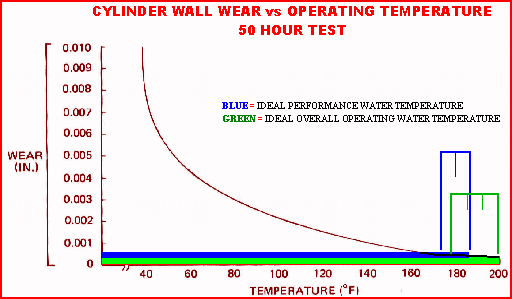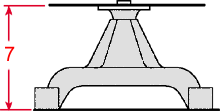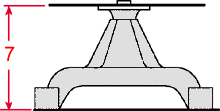 Chevelle Water Pumps and Accessories |
El Camino Water Pumps and Accessories
Chevelle Water Pumps and Accessories |
El Camino Water Pumps and Accessories
Chevrolet V8 Water Pumps
|
Chevrolet used two general water pump designs for 1964 to
1972 V8 Chevelles, one for each V8 engine size - the small
block 283-400 and the big block 396-454.
All Chevelles up to and including 1968 used what's commonly referred to as a "short pump" and from 1969 to 1972, a "long pump." Both the small block and the big block used a short or long pump. Either the short or long pump may be used with its respective engine as long as you also use the corresponding brackets and pulleys. The general rule of thumb is if you can put your fingers between the back of the water pump and the timing cover, it's a long pump; if you can't, it's a short pump. The photos show the length of each pump. While there is room to put a long pump and its brackets and pulleys into an originally short pump car, you must be very mindful of the fan-to-radiator clearance. I've also discovered that while most factory big block pumps use a 2-inch lower hose outlet, some aftermarket big block pumps (such as the TuffStuff unit - also sold by Summit Racing) use a 1.75-inch outlet. There may be others, but this one I'm familiar with. Not saying this is good or bad, just something to be aware of. Reverse rotation pumps are used on many serpentine belt systems and cannot be used in place of normal rotation pumps. |
|

Keep in mind that thermostats have absolutely NO effect on your systems ability to cool, simply a regulator of the range it operates in. So, if you think a 160 will cure an engine running at 220 with a 180 thermostat, forget about it!
The graph above illustrates the importance of critical optimum coolant temperature is to the longevity and performance your engine. Cooler water makes horsepower and warmer water minimizes engine cylinder and bearing wear, or so it's commonly thought, but only to their own limits and ranges. There is a range where both optimum performance as well as minimal wear share similar characteristics. That number lies in the 175-180 degree range as shown by the overlap in the chart which correspondingly requires a 180 degree thermostat. FWIW, higher operating temperatures of today's engines are to fight combustion by-products and pollution. Also, engine oils are designed to work over a specific temperature range with optimum performance starting at temperatures that require the coolant to be the very same 175ish range.
Don't forget the moisture issue. Have you ever seen water vapor coming from your tailpipes? The very same thing happens INSIDE your engine. Your engine forms moisture inside when it cools and condensates. This moisture there is washed down into the oil when started and then awaits vaporization by internal temperatures rising enough to bring the moisture to the appropriate corrected boiling point. If enough moisture is left behind it combines with combustion byproducts to form acids that become dissolved in the oil itself. The oil becomes more acidic as the age of the oil progresses and picks on certain parts eventually. Also moisture will corrode other surfaces. So it's important to get your engine to a satisfying operating temperature as soon as possible. Usually oil pooling temps are about 30 to 40 degrees higher than the coolant temps. This is a generalized statement and can vary with load and engine design but you can see why you want your oil over 212 degrees to boil out the moisture immediately!
Years of research show use of 160 degree thermostats is way too
low to be considered for performance or engine longevity. As the
chart above illustrates, engine wear increased by DOUBLE at 160,
than at 185 degrees. The 160s were invented for and commonly used in
older, open loop cooling systems where only 6 pound radiator caps
were used, and low 212 degree boiling points were the limit. We know
better now.
Many early hot rodders found the 160s to be a smidgen better
performing than the 195s, however the in between 180 appears to
satisfy both ends of the spectrum. The correct water temperature and
thus resulting metal operating temperatures required for the
cylinders to achieve a minimum specific temperature in order to
allow a fully mixed Air/Fuel charge to combust efficiently is a
minimum of 180 degrees coincidentally. If you use 160s be aware that
this can have a degrading effect over a time on your engine. I know
a lot of rodders still using them however to whatever ends they
want...and that's okay. I just report what I learn and you decide
what's best for you. I hope this satisfies you information junkies
out there.
(Credit to
http://www.carnut.com/ramblin/cool3.html, spelling & grammatical
errors were corrected and some phrases simplified)
 Chevelle Water Pumps and Accessories |
El Camino Water Pumps and Accessories
Chevelle Water Pumps and Accessories |
El Camino Water Pumps and Accessories

 Home
Home Decode
Decode Tech
Tech Tools
Tools Dale's Coins/CDs
Dale's Coins/CDs Contact
Contact Chevelle
of the Month
Chevelle
of the Month Things
For Sale
Things
For Sale Custom
Stickers
Custom
Stickers



